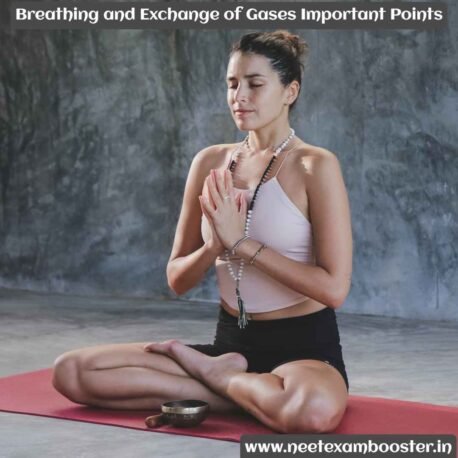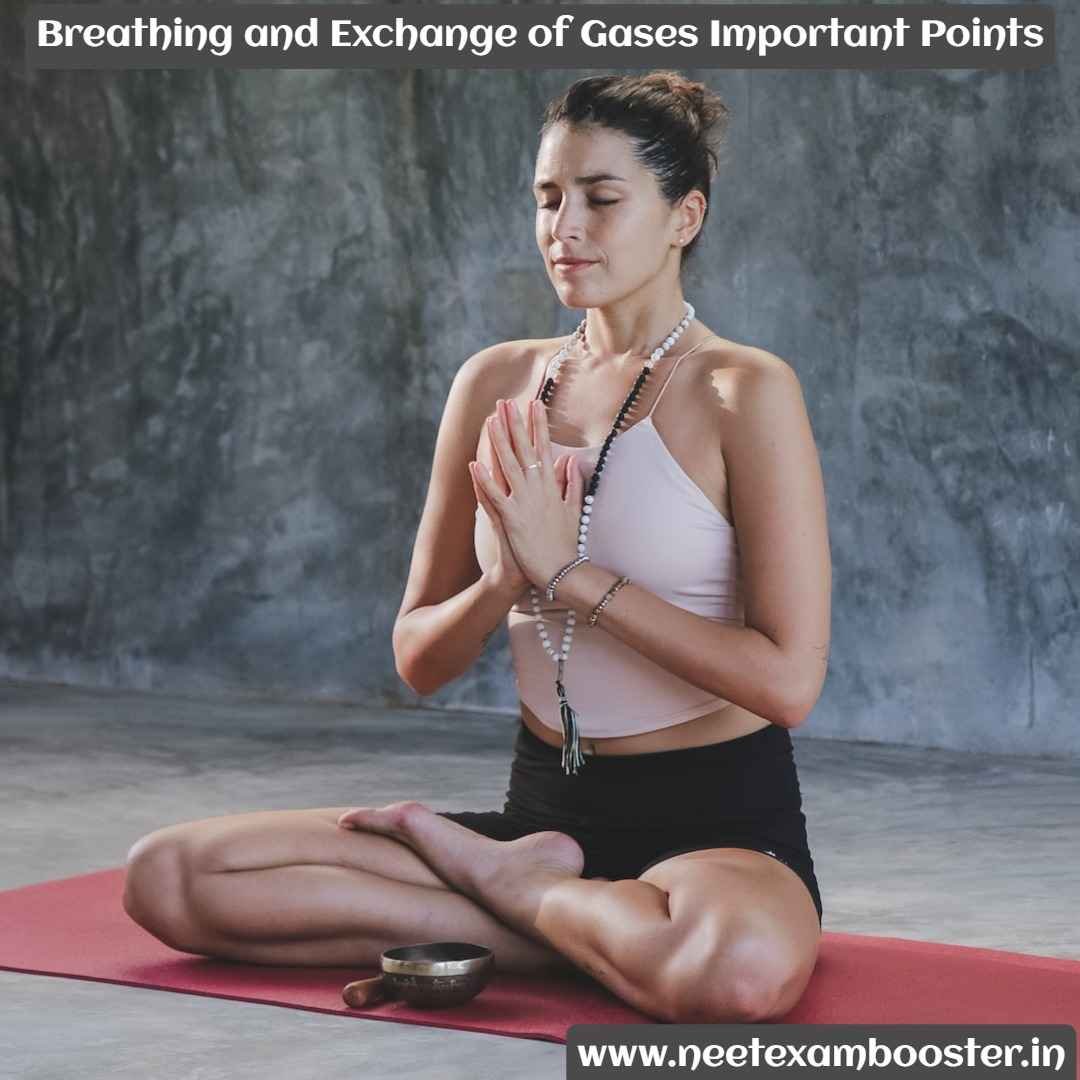Breathing and exchange of gases important points: Breathing is a vital process that involves inhaling and exhaling the air to deliver oxygen to body’s cells and remove the carbon dioxide, a waste product of the cellular respiration. It is controlled by respiratory center in brain and is influenced by levels of the carbon dioxide and oxygen in blood and brain.
During the process of inhalation, air is drawn into the lungs and reaches alveoli, tiny air sacs where the exchange of gases occurs between the air and blood. Oxygen diffuses into blood and carbon dioxide diffuses out into the air.
The rate of the breathing is influenced by the various factors, including level of carbon dioxide and oxygen in the blood, altitude, temperature, humidity, and medical conditions such as asthma and sleep apnea. Improving the overall health, practicing proper breathing techniques, and engaging in the physical activity can improve efficiency of the gas exchange in the lungs.
Breathing and exchange of gases important points, Breathing and exchange of gases important points, Breathing and exchange of gases important points, Breathing and exchange of gases important points, Breathing and exchange of gases important points, Breathing and exchange of gases important points, Breathing and exchange of gases important points
NCERT Biology Class 11 Chapter 17, 25 important points on Breathing and exchange of gases important points
There are 25 important points on breathing and exchange of gases:

1. Breathing is a process of inhaling and exhaling the air to transport the oxygen to the body’s cells and remove the carbon dioxide.
2. The purpose of breathing is to deliver the oxygen to the body’s cells and remove the carbon dioxide, a waste product of the cellular respiration.
3. Breathing is controlled by respiratory center in the brain, which is influenced by level of carbon dioxide in the blood and level of oxygen in the brain.
4. During the process of inhalation, air is drawn into lungs through the mouth or the nose, passing through pharynx, larynx, trachea, and bronchi before reaching the alveoli.
5. The alveoli are the tiny air sacs in the lungs where exchange of the gases occurs between the air and the blood.
6. Oxygen from air diffuses into the blood in alveoli, where it binds to the hemoglobin molecules in red blood cells.
7. Carbon dioxide, a waste product of the cellular respiration, diffuses from blood into the alveoli, where it is exhaled into atmosphere.
8. Rate of breathing is influenced by level of carbon dioxide in the blood and level of oxygen in the brain.
9.When the carbon dioxide levels in blood increases , the respiratory center in the brain signals the muscles of the respiration to increase the rate of breathing, which increases elimination of carbon dioxide.
10. When the oxygen levels in the blood decreases, the respiratory center signals the muscles of the respiration to increase rate of breathing, which increases the delivery of the oxygen to the body’s cells.
11. Surface area of the alveoli is large to facilitate exchange of the gases between the air and the blood.
12. The walls of alveoli are quite thin to allow for efficient diffusion of gases.
13. The pulmonary capillaries surrounding alveoli transports the oxygen-rich blood to the body’s cells and return the carbon dioxide-rich blood to the lungs.
14. Oxygen-hemoglobin bond is reversible, allowing the oxygen to be released from blood and bind to the hemoglobin as needed.
15. The exchange of gases in alveoli is influenced by pressure gradient between the air in alveoli and the blood in the pulmonary capillaries.
16. The pressure gradient is maintained by respiratory muscles, which controls the volume of the air in the lungs and the pressure within the alveoli.
17. The process of breathing is also influenced by the factors such as altitude, temperature, and humidity, which affect the concentration of gases in the air.
18. Breathing can be impacted by a variety of medical conditions, including the asthma, chronic obstructive pulmonary disease (COPD), and sleep apnea.
19. These conditions can cause airways to become narrow, making it difficult to breathe, or can disrupt normal function of the respiratory center, causing the irregular breathing patterns.
20. The exchange of the gases can also be impacted by the certain drugs, such as anesthesia, which depresses the respiratory center, and alcohol, which can cause the respiratory depression.
21. The proper breathing techniques, such as deep breathing and diaphragmatic breathing, can help to improve the efficiency of the gas exchange in the lungs.
22. Physical activity, such as exercise, can also increase the efficiency of the gas exchange by increasing rate and depth of breathing and increasing circulation of the blood.
23. Maintaining a good overall health, including a healthy diet and avoiding smoking, can help to support the normal functioning of respiratory system and improves the exchange of gases in the lungs.
24. Mechanism of Breathing: Breathing involves contraction and relaxation of diaphragm and intercostal muscles, which increases and decreases volume of the chest cavity. This change in the volume creates the pressure differences that causes the air to flow in and out of the lungs.
25. Importance of Breathing: Maintaining the proper breathing pattern is essential for the overall health and well-being. Good breathing helps to improve the oxygen delivery to the cells, removes waste products, and regulates the acid-base balance in the body. It can also have a positive effect on the nervous system, helping to reduce the stress and promote relaxation.
Some Important Questions From Biology Class 11
| Chapter Name | Quiz Link |
| The Living World | Play Now |
| Biological Classification | Play Now |
| Plant Kingdom | Play Now |
| Animal Kingdom | Play Now |
| Morphology of flowering plants | Play Now |
| Anatomy of flowering plants | Play Now |
| Cell: the unit of life | Play Now |
| Biomolecules | Play Now |
| Cell Cycle and cell division | Play Now |
| Transport in Plants | Play Now |
| Structural organisation in Animals | Play Now |
| Mineral nutrition | Play Now |
| Photosynthesis in higher plants | Play Now |
| Respiration in plants | Play Now |
| Plant Growth and development | Play Now |
| Digestion and Absorption | Play Now |
| Breathing and Exchange of Gases | Play Now |
| Body fluids and circulation | Play Now |
| Excretory products and their elimination | Play Now |
| Locomotion and Movement | Play Now |
| Neural Control and Coordination | Play Now |
| Chemical Coordination and Integration | Play Now |
Some Important Questions From Biology Class 12
| Chapter Name | Quiz Link |
| Reproduction in organism | Play Now |
| Sexual reproduction in flowering plant | Play Now |
| Human reproduction | Play Now |
| Reproductive health | Play Now |
| Principles of inheritance and variation | Play Now |
| Molecular basis of inheritance | Play Now |
| Evolution | Play Now |
| Human health and disease | Play Now |
| Strategies for enhancement in food product | Play Now |
| Microbes in human welfare | Play Now |
| Biotechnology principles and processes | Play Now |
| Biotechnology and its application | Play Now |
| Organism and population | Play Now |
| Ecosystem | Play Now |
| Biodiversity and its conservation | Play Now |
| Environment issue | Play Now |




















Pingback: Biology Important Points For NEET Class 11 And Class 12
Pingback: Biology Important Points For NEET Class 11 - NCERT Biology